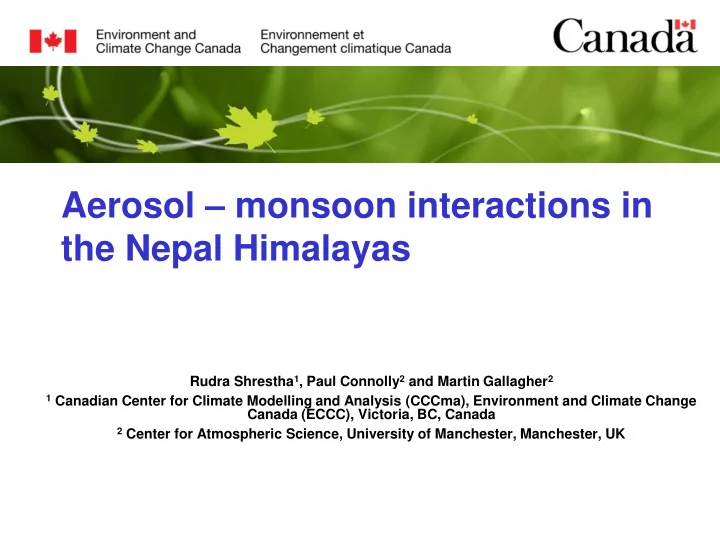

Aerosol – monsoon interactions in the Nepal Himalayas Rudra Shrestha 1 , Paul Connolly 2 and Martin Gallagher 2 1 Canadian Center for Climate Modelling and Analysis (CCCma), Environment and Climate Change Canada (ECCC), Victoria, BC, Canada 2 Center for Atmospheric Science, University of Manchester, Manchester, UK
Overview Monsoon mechanisms Motivation WRF model simulations Summary
Monsoon mechanism ERA-40 Analysis 1958 – 1997 (Turner, 2005)
ERA-40 Analysis (200-500hpa) temp. (Turner, 2005)
Precipitation data 1979 – 1997 (Turner, 2005)
Topography (Webster et. al. 1988)
Aerosol Delayed warm rain, and prolonged cloud life time by aerosols in a monsoon (moisture- rich) environment may invigorate deep convection (Rosenfeld et al., 2008)
Elevated Heat Pump (EHP) Hypothesis (Lau et al., 2006) Other factors such as ENSO, MJO etc…
Motivation: Understanding of the Indian monsoon The Himalaya region is also known as ‘third pole’ or ‘water tower of Asia’ due to its huge reserves of ice. Over 1.3 billion people in the region are dependent on monsoon precipitation for agriculture and hydro-electricity. Advected aerosols from the Indo-Gangetic plains are thought to play a significant role in modulating orographic precipitation in the foothills of the Himalayas. (Morwal et al, 2012) (Shrestha and Barros, 2010)
Motivation: Understanding the Indian Monsoon (IPCC, 2014) Future rises in the global temperature increase the moisture holding capacity of air, the ‘ Clausius-Clapeyron effect ’.
Model Simulations: microphysical processes Cold Cloud Processes Warm Cloud Processes (Source:www.met.sjsu.edu)
Aerosol indirect effects Increased CCN concentration increases cloud albedo (Twomey or 1 st indirect effect) which in turn reduces precipitation efficiency (Albrecht or 2 nd indirect effect) Warm cloud direct and indirect effects (IPCC, 2007)
The Clausius – Clapeyron relationship Relationship between temperature and moisture holding capacity of atmosphere. At constant relative humidity, specific humidity is increased by 7% K -1 e s In a warming climate this Pressure increases the potential for heavy precipitation in storms. This is because there is enhancement by additional latent heat release which Temperature invigorates the storm.
Key questions How will the monsoon precipitation be affected by pollution and global warming? How sensitive is the monsoon to perturbations in aerosol and temperature? How is the spatial distribution of the monsoon affected by aerosol perturbations?
Experimental Design WRF V3.1 model, 3 nested domains: 27, 9, & 3km horizontal resolution, with 40 vertical layer, centred on central Nepal. The model is coupled with a bulk microphysics scheme, set up to resolve convective motions explicitly. Initial and boundary conditions from NCEP/DOE reanalysis II (2.5 x 2.5 deg.x 17; 1.875 x 1.875 deg.) Morrison Double Moment microphysics scheme
Experimental Design contd … Atmospheric moisture is altered by perturbing the temperature i) uniformly and ii) randomly across the atmosphere by modifying the code and holding the relative humidity constant. Uniform is perhaps more realistic though The aerosol is introduced in the model in three different scenarios: ‘Low’ – (500/cm 3 ), ‘Medium’ – (1500/cm 3 ) and ‘High’ – (3500/cm 3 ) concentrations. We modified the code to predict CCN as a function of time and height in the ‘prognostic CCN’ scenario. This is more realistic. The sensitivity of rainfall to changes in background aerosol and temperature was analyzed for three real-world case studies covering different seasons of the year with varying rainfall intensity. A total of 45 WRF simulations were produced and analysed.
Precipitation Sensitivity: Uniform Temp. perturbation T ctrl T = +5 T = +10 Low Medium High
Domain and Time averaged Rainfall Uniform Temp. Pert. Random Temp. Pert. Prognostic CCN
Effect on Droplet Concentration Random Temp. pert. Uniform Temp. pert. Prognostic CCN
Effect on Ice Concentration Random Temp. pert. Uniform Temp. pert. Prognostic CCN
Cloud Structure T ctrl Cases Medium Low Units: g/kg High
Summary The model showed a good representation of aerosol 1 st indirect (Twomey) effect, however rainfall is not sensitive to the aerosol perturbations used (-2% to +4%). Ice phase processes played a crucial role to buffering the sensitivity but current understanding of the impact of aerosol on ice phase processes is poorly documented.
Summary The effect of temperature is more than the aerosol effect, ranging from -17% to +93%. Aerosol perturbations can modify shape, size and spatial distribution of individual cloud regions and their precipitation. Improved parameterizations of aerosol effects on ice phase processes is necessary in order to accurately simulate the precipitation particularly where the ice phase is a dominant process such as in the Himalayas.
Recommend
More recommend